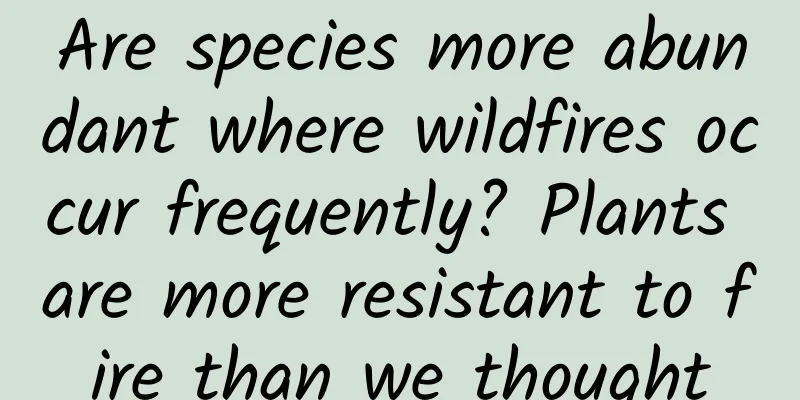Are species more abundant where wildfires occur frequently? Plants are more resistant to fire than we thought

|
Wildfires cannot be extinguished, and spring breezes will bring them back. Since 2023, global fires have intensified, and to some extent, they are constantly reshaping the ecological landscape of the earth. The Canadian forest fire is the most representative fire event. According to the latest data from the Canadian Forest Fire Centre, as of July 26 local time, a total of 4,774 fires have occurred across the country, with a cumulative burned area of more than 121,000 square kilometers, exceeding the land area of South Korea (about 103,000 square kilometers). It is 7.5 times the cumulative forest fire-affected area in my country from 2000 to 2021, and carbon dioxide emissions have reached 1 billion tons. Wildfire burns forest east of Canada's Bush River In addition, the fire on Maui Island in Hawaii, the large-scale fire in the Pantanal wetlands in western Brazil, and the forest fire in Greece have turned 2023 into an unusual "year of fires." Stephen Pine, an emeritus professor at Arizona State University in the United States who specializes in environmental history, believes that humans have entered the "Pyrocene." The natural world of “walking with fire” With fires occurring frequently today, the most affected are plants in nature. However, plants are more tolerant of fire than we thought. Charcoal fossils from 400 million years ago prove that plants had to face the threat of fire a long time ago. Some studies have shown that gymnosperms had some characteristics adapted to fire about 100 million years ago, and the widespread spread of angiosperms in the Cretaceous was also related to the high oxygen content in the atmosphere and frequent fires at that time. Over the centuries of "living with fire", adaptation to fire has given some plant lineages an advantage in competition. For example, the spread and diversification of pine, the largest genus of gymnosperms, contains more than 100 species and occupies vast coniferous forests in the Northern Hemisphere. Its adaptation to fire is closely related to its expansion and diversification. In addition, there is an inseparable connection between fire and climate. For example, the Mediterranean climate, with hot and dry summers and mild and rainy winters, is prone to forest fires. Today, the world's five Mediterranean climate zones account for about 1.2% of the world's land area, but are home to about one-sixth of the world's plant species. Global distribution of Mediterranean climate regions In a Mediterranean climate, frequent fires almost always occur in hot and dry summers, which makes fires highly periodic and predictable, thereby changing the evolutionary direction of local plants. So, how can we make good use of the relationship between fire and species renewal? On July 19, 2023, a review article published in the journal Trends in Ecology & Evolution, a Cell Press publication, pointed out that by integrating a large number of studies on the rapid evolution of animals in response to fire, a team of interdisciplinary experts hopes to use the known information to help promote evolution-based conservation plans. They believe that in this way, we can try to use the way fire affects animals to protect vulnerable species in turn. In other words, cooperate with evolution instead of fighting it. The climate crisis brought by the Pyrocene Another topic that people are concerned about is what impact the frequent fires around the world since 2023 have on plant species? The answer may not be optimistic. Liu Junyan, head of Greenpeace's climate risk project, said: "In recent years, wildfires have become more frequent around the world, far exceeding the scale of wildfires as a natural phenomenon." In a natural state, the burning of wildfires contributes to the sustainable development of forests and is a normal cycle. But now, with the intensification of wildfires, this cycle has been broken. For example, the fires in Australia and the Amazon forests, the large areas burned make it basically impossible for the forests in these areas to recover in the next few years, and it is impossible to form a self-cycle. With the impact of human deforestation and wildfires, these areas are gradually becoming "accomplices" in emitting carbon dioxide and exacerbating the climate crisis. It can be seen that frequent and intensified wildfires will have a very serious impact on the ecosystem and the global climate. So can the increasingly frequent fires around the world be avoided? In fact, as early as February 2022, the United Nations Environment Programme released a report titled "Spreading Like Wildfire: The Growing Threat of Extreme Fires", which pointed out that climate change and changes in land use are expected to make wildfires more frequent and more intense, and predicted that by 2030, global extreme wildfires will increase by 14%, by 2050 by 30%, and by the end of this century by 50%. In addition to countries and regions where wildfires have frequently occurred in the past, some regions that were not previously affected by wildfires, such as the Arctic, are also experiencing an increasing risk of wildfires. Photos released by Maui County, Hawaii, U.S. on August 10 show serious damage caused by wildfires Against this backdrop, on December 7, 2023, at the 28th United Nations Climate Change Conference, the Chinese Academy of Sciences released the Blue Book on Carbon Emissions from Forest Fires (2023) (hereinafter referred to as the "Blue Book"). The Blue Book shows that in the 22 years from 2001 to 2022, global forest fires emitted a total of 33.9 billion tons of carbon dioxide, with an average annual forest burn area of 46.95 million hectares, 11 times the average annual growth area of artificial forests during the same period. Forest fires have become a source of carbon emissions that cannot be ignored. Experts call for incorporating forest fire carbon emissions into the global carbon accounting system in the future, while strengthening the prevention and management of extreme forest fires, deepening relevant scientific research and international cooperation, and jointly responding to global climate change. This shows that we are not powerless in this "Pyrocene". As long as countries around the world take up their respective responsibilities and take relevant measures such as forest fire control and climate action, they can minimize the series of serious disasters caused by climate change. |
Recommend
Master sharing: A practical summary of earning one million yuan a year by working part-time on Douyin Mini Program
Master sharing: A practical summary of earning on...
See the big picture from the small details and make science within reach: Science Popularization China Lite is here!
On January 16, 2024, at the "2023 Science Po...
Lu Mingming's "WeChat Group Precision Traffic Drainage Training Camp 3.0" uses WeChat groups to conduct traffic diversion operations and create a private domain traffic pool
Course Contents: 1. Understand the advantages of ...
Overseas video marketing and promotion skills!
There is no doubt that a large portion of the pop...
Features of APP promotion, characteristics of App promotion
Low cost The APP promotion model is based on mobi...
18 tips for writing a good beginning and ending for a public account article!
A few days ago, I saw someone say on Zhihu: "...
Don’t miss out on these creative information flow techniques that can increase your results 10 times!
With the explosion of information flow advertisin...
Want a “screen-sweeping” promotion for NetEase Music? Here are 8 ways
Why does the traffic increase when users are mock...
How did you spend the Dragon Boat Festival holiday? Tourism revenue in the first two days of the Dragon Boat Festival holiday was 9.66 billion yuan
According to the official Weibo of the Ministry o...
Boss Dai from Fantong: "Yuanchuan Investment Academy"
Boss Dai from Fantong: "Yuanchuan Investment...
Alipay and WeChat payment codes are restricted. What will happen to individual merchants?
Today, a piece of news swept the Internet, saying...
Curious question for the Year of the Snake! Can “snakes” also bear fruit? Actually…
Review expert: Dong Wenpan, associate professor o...
Top 1000 Mobile Apps with the Most Active Users in October
This article shares with you the TOP 1000 mobile ...
Review and practice: How to conduct a group fission activity that can generate 100+ communities?
I am a person who is most afraid of writing, beca...
Even bullets can’t break it, why is Rupert’s Tear so magical?
There is a very interesting little thing called &...



![[Smart Farmers] Magnolias are both beautiful and talented: they are more than just for viewing](/upload/images/67f21690d4793.webp)





